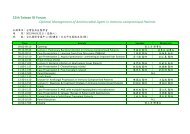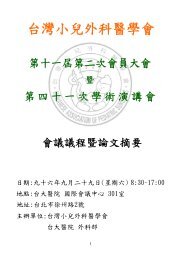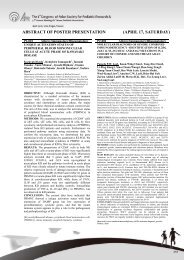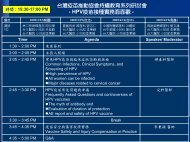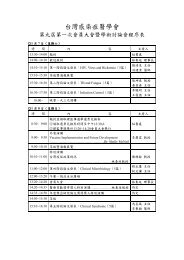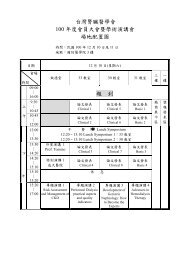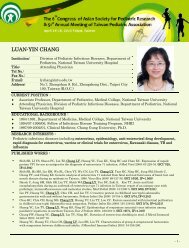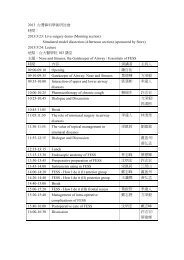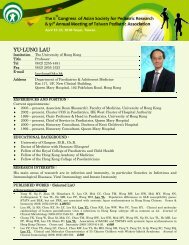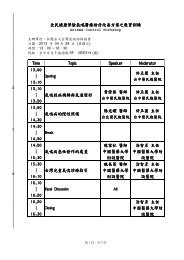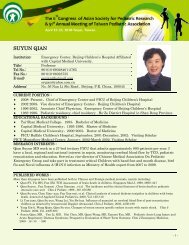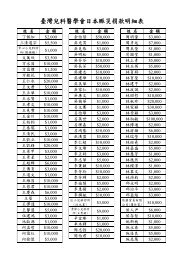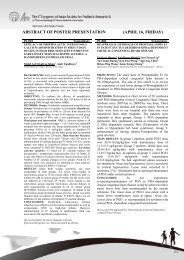ABSTRACT OF INVITED LECTURES AND ORAL PRESENTATION
ABSTRACT OF INVITED LECTURES AND ORAL PRESENTATION
ABSTRACT OF INVITED LECTURES AND ORAL PRESENTATION
- No tags were found...
You also want an ePaper? Increase the reach of your titles
YUMPU automatically turns print PDFs into web optimized ePapers that Google loves.
FP7-03SUCCESSFUL PREDICTION <strong>OF</strong> SEASONALINFLUENZA EPIDEMIC STRAINS THROUGHEARLY SURVEY <strong>OF</strong> SEROPROTECTIONRATE IN CHILDREN IN TAIWANWei-Ju Su, 1,2 Pei-Lan Shao, 2 Ming-Tsan Liu, 1Ding-Ping Liu, 1 Kuo-Chin Huang 3 , Luan-YinChang, 2 Chun-Yi Lu, 2 Jen-Ren Wang, 4 Hsin-RuShih, 5 Daniel Tsung-Ning Huang, 6 Shin Chi, 6Li-Min Huang 21 Centers for Disease Control, Taiwan; Departments of Pediatrics 2 andFamily Medicine 3 , National Taiwan University Hospital; 4 Natioanl ChengKung University; 5 Chang Gung University; 6 Department of Pediatrics,Mackay Memorial Hospital (Taiwan)BACKGROUND: Many vaccine-like strains circulated inTaiwan at least 1 to 2 years before being recommended asvaccine strains by the WHO. We wanted to discover theserological signals which indicated the possible dominantlycirculating subtype in the coming influenza winter seasons.METHODS: In Taiwan, the winter season was generallyrecognized from December to February. Healthy children aged6 months-5 years, adults aged 18-60 years, and elderly aged>60 years living in Taipei City and Taipei County wererecruited to receive seasonal trivalent inactivated influenzavaccination from October to December during 2006/2007 to2008/2009 seasons. Serum pairs were collected at baseline and3 weeks post-immunization. Influenza local strains circulatingearly in October were provided by the laboratory-surveillancenetwork coordinated by Taiwan CDC. Using ahemagglutination inhibition (HAI) assay, we measuredantibody responses to three subtypes of influenza local strainsin stored serum pairs.RESULTS: A total of 1079 subjects of three age strata wereenrolled and HAI antibody response after seasonal influenzavaccination met the criteria of sero-protection rate set up bythe Europe's Committee for Medicinal Products for HumanUse. Among them, 301 subjects were randomly assigned to betested for local strains, which included 80, 120, and 101subjects in 06/07, 07/08, and 08/09 seasons, respectively. Thelaboratory-based surveillance network indicated thatB/Malaysia/2506/2004-like in 06/07 season,A/Brisbane/59/2007-like virus (H1N1) in 07/08 season, andA/Brisbane/59/2007-like virus (H1N1) in 08/09 season werethe dominant winter influenza strains in Taiwan. The lowestproportion of subjects with HAI titer ≥ 40 at baseline wasobserved in children against the B/Taiwan/0050/2006 in 06/07season, A/Taiwan/785/2006 (H1N1) in 07/08 season, andA/Taiwan/951/2007 (H1N1) in 08/09 season, which correlatedwell with the circulating influenza subtype in the followingwinter peak seasons.CONCLUSION: Low seroprotection rate in children againsta specific locally circulating strain predicted the dominantlycirculating subtype of influenza virus in the coming winterseason. A year-end pre-seasonal serology survey may bewarranted to identify the possible circulating strain and tailorthe disease-control strategy accordingly.FP7-04PREVALENCE <strong>OF</strong> DRUG-RESISTANT VIRUSES<strong>AND</strong> VIRUS-SHEDDING PERIOD IN PEDIATRICINFLUENZA PATIENTS TREATED WITHOSELTAMIVIR OR ZANAMIVIRDaisuke Tamura, M.D., 1 Norio Sugaya, M.D., 2 MasatakaIchikawa, M.D., 3 Masahiko Yamazaki, M.D., 4 ChiharuKawakami, 5 Hideaki Shimizu, 6 Ritei Uehara, M.D., Ph.D., 7Maki Kiso, D.V.M., Ph.D., 1 Eiryo Kawakami, M.D., 1 KeikoMitamura, M.D., 8 and Yoshihiro Kawaoka, D.V.M.,Ph.D. 1,9,10,111 Division of Virology, Department of Microbiology and Immunology, Institute ofMedical Science, University of Tokyo, Shirokanedai, Minato-ku, Tokyo, Japan;2 Department of Pediatrics, Keiyu Hospital, Kanagawa, Japan; 3 Department ofPediatrics, Ichikawa Children’s Clinic, Kanagawa, Japan; 4 Department ofPediatrics, Zama Children’s Clinic, Kanagawa, Japan; 5 Yokohama City Instituteof Public Health, Kanagawa, Japan; 6 Kawasaki City Institute of Public Health,Kanagawa, Japan; 7 Department of Public Health, Jichi Medical University,Tochigi, Japan; 8 Department of Pediatrics, Eiju General Hospital, Tokyo, Japan;9 ERATO Infection-Induced Host Responses Project, Japan Science andTechnology Agency, Saitama, Japan; 10 International Research Center forInfectious Diseases, Institute of Medical Science, University of Tokyo,Shirokanedai, Minato-ku, Tokyo, Japan; 11 Department of PathobiologicalSciences, University of Wisconsin, Madison, WI, USA.OBJECTIVES: Although reports of influenza viruses resistantto a neuraminidase inhibitor zanamivir are much less thanthose of another neuraminidase inhibitor oseltamivir-resistantclinical isolates, it is unknown whether this is due to thelimited use of zanamivir or a property of the drug. To comparethe prevalence of drug-resistant viruses and virus-sheddingperiod in seasonal influenza virus-infected children treatedwith either oseltamivir or zanamivir.METHODS: Clinical specimens (throat or nasal swab) werecollected from a total of 144 pediatric influenza patients duringthe 2005-2006, 2006-2007, 2007-2008, and 2008-2009influenza seasons. Neuraminidase inhibitor-resistant mutantswere detected among the isolated viruses by sequencing theviral hemagglutinin and neuraminidase genes. Sensitivity ofthe viruses to neuraminidase inhibitors was tested by sialidaseinhibition assay.MAIN RESULTS: In oseltamivir- or zanamivir-treatedinfluenza patients who were statistically comparable in theirage distribution, vaccination history, and type or subtype ofvirus isolates, the virus-shedding period in zanamivir-treatedpatients was significantly shorter than that inoseltamivir-treated patients. Further, the prevalence ofzanamivir-resistant viruses was significantly lower than that ofoseltamivir-resistant viruses.CONCLUSION: In comparison to treatment with oseltamivir,treatment of pediatric patients with zanamivir resulted in theemergence of fewer drug-resistant influenza viruses and ashorter virus-shedding period. We conclude that zanamivirshows promise as a better therapy for pediatric influenzapatients.[Keywords] Influenza virus, neuraminidase inhibitor, Oseltamivir,Zanamivir[Keywords] prediction, epidemic strains, influenza, children,haemagglutinin inhibition titers82



